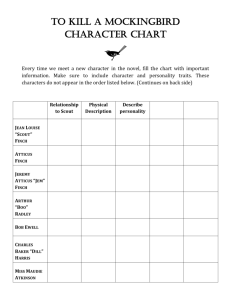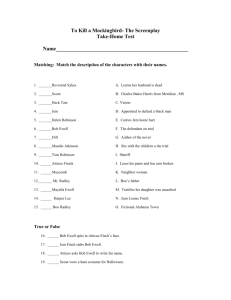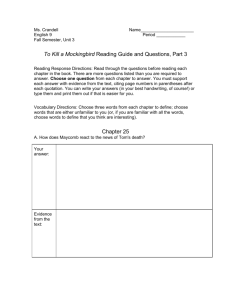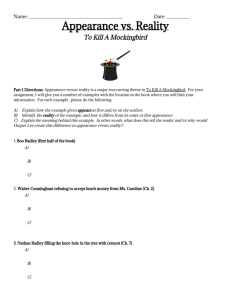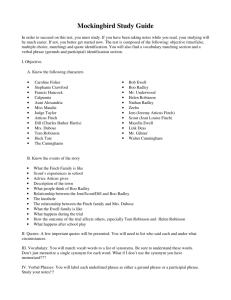Analyze the relationship between Boo Radley and the children. How
advertisement
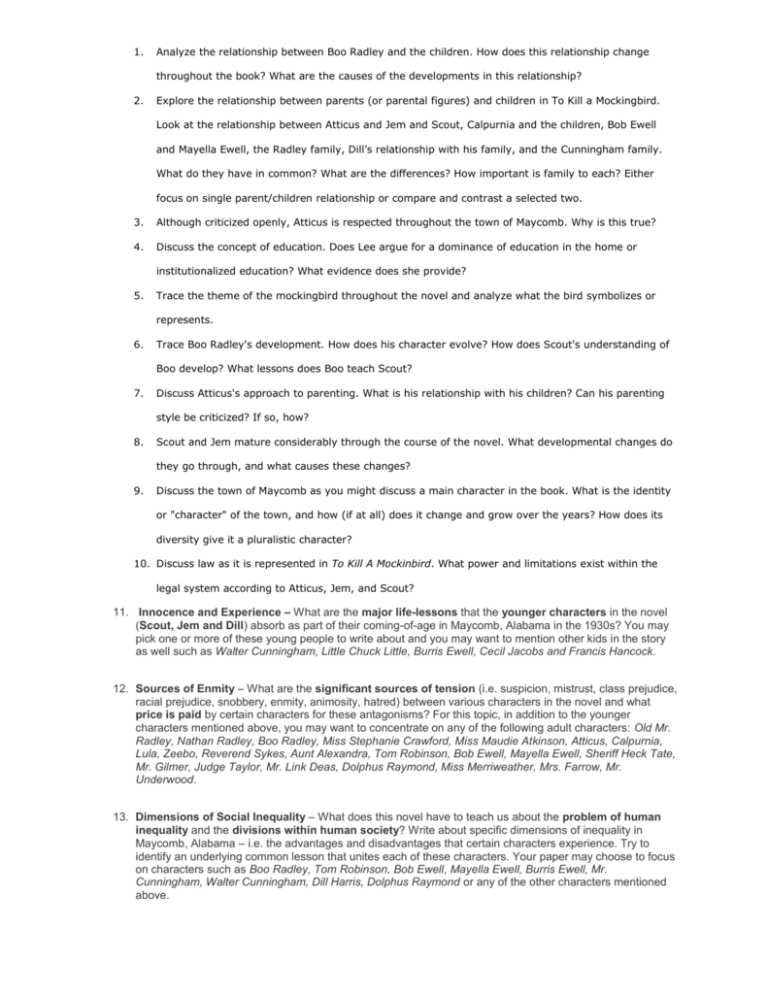
1. Analyze the relationship between Boo Radley and the children. How does this relationship change throughout the book? What are the causes of the developments in this relationship? 2. Explore the relationship between parents (or parental figures) and children in To Kill a Mockingbird. Look at the relationship between Atticus and Jem and Scout, Calpurnia and the children, Bob Ewell and Mayella Ewell, the Radley family, Dill’s relationship with his family, and the Cunningham family. What do they have in common? What are the differences? How important is family to each? Either focus on single parent/children relationship or compare and contrast a selected two. 3. Although criticized openly, Atticus is respected throughout the town of Maycomb. Why is this true? 4. Discuss the concept of education. Does Lee argue for a dominance of education in the home or institutionalized education? What evidence does she provide? 5. Trace the theme of the mockingbird throughout the novel and analyze what the bird symbolizes or represents. 6. Trace Boo Radley's development. How does his character evolve? How does Scout's understanding of Boo develop? What lessons does Boo teach Scout? 7. Discuss Atticus's approach to parenting. What is his relationship with his children? Can his parenting style be criticized? If so, how? 8. Scout and Jem mature considerably through the course of the novel. What developmental changes do they go through, and what causes these changes? 9. Discuss the town of Maycomb as you might discuss a main character in the book. What is the identity or "character" of the town, and how (if at all) does it change and grow over the years? How does its diversity give it a pluralistic character? 10. Discuss law as it is represented in To Kill A Mockinbird. What power and limitations exist within the legal system according to Atticus, Jem, and Scout? 11. Innocence and Experience – What are the major life-lessons that the younger characters in the novel (Scout, Jem and Dill) absorb as part of their coming-of-age in Maycomb, Alabama in the 1930s? You may pick one or more of these young people to write about and you may want to mention other kids in the story as well such as Walter Cunningham, Little Chuck Little, Burris Ewell, Cecil Jacobs and Francis Hancock. 12. Sources of Enmity – What are the significant sources of tension (i.e. suspicion, mistrust, class prejudice, racial prejudice, snobbery, enmity, animosity, hatred) between various characters in the novel and what price is paid by certain characters for these antagonisms? For this topic, in addition to the younger characters mentioned above, you may want to concentrate on any of the following adult characters: Old Mr. Radley, Nathan Radley, Boo Radley, Miss Stephanie Crawford, Miss Maudie Atkinson, Atticus, Calpurnia, Lula, Zeebo, Reverend Sykes, Aunt Alexandra, Tom Robinson, Bob Ewell, Mayella Ewell, Sheriff Heck Tate, Mr. Gilmer, Judge Taylor, Mr. Link Deas, Dolphus Raymond, Miss Merriweather, Mrs. Farrow, Mr. Underwood. 13. Dimensions of Social Inequality – What does this novel have to teach us about the problem of human inequality and the divisions within human society? Write about specific dimensions of inequality in Maycomb, Alabama – i.e. the advantages and disadvantages that certain characters experience. Try to identify an underlying common lesson that unites each of these characters. Your paper may choose to focus on characters such as Boo Radley, Tom Robinson, Bob Ewell, Mayella Ewell, Burris Ewell, Mr. Cunningham, Walter Cunningham, Dill Harris, Dolphus Raymond or any of the other characters mentioned above.
